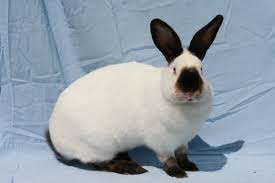
CALIFORNIAN - Nikki White (Reguli Cavy & Rabbit Stud)

This is a fur rabbit. The BRC standard calls for a very plump bunny, full over and around the hips with a firm meaty saddle. The flesh is to be firm and solid and not loose or flabby. The head should be well shaped, medium full and carried erect on a short neck set close to the body. The ears should be in proportion to the size of the body, well set on the head, heavy at the base and carried straight up. The eyes should be bright and bold and pink in colour. The feet and legs should be medium light bone, the toenails horn coloured or showing pigmentation, the fur should have as dense an undercoat as possible interspersed with plenty of coarser guard hairs and it should resume its position immediately it is rubbed the wrong way. The colour of the nose, feet, ears and tail should be as dark as possible and the body should be pure white. The tail should be straight and carried erect, its length and size should be in proportion to the body. They come in Black, Chocolate, Blue and Lilac.
Faults include long slim heads with pinched nose, heavy open spoon-shaped ears, eyes faded in colour, light toenails, fur of a woolly texture, light shading in the coloured section due to moult.
Disqualifications include a resemblance to a Flemish or a Himalayan type, long rangy body, poor meat type, head out of proportion to the size of the body, ears without marking colour, long or heavy bone, one or more white toenails, colour extending on to the body above the junction of the front legs with the body, white spots in coloured section, absence of colour on nose and ears and being outside the weight limits (adult buck 3.4 kg to 4.53 kg; adult doe 3.4 kg to 4.7 kg)
HISTORY
Unlike the New Zealand, this one's name really does reflect its place of origin. This bunny is a genuine Valley Girl (or Boy) being created by breeder, George West in Southern California in the 1920s. West wanted to develop a meat rabbit which also had a good quality pelt. He crossed Chinchillas with Himalayans, then crossed the offspring with New Zealand Whites. Originally called an Ermine or a Cochinella, they were first shown in California in 1928. In 1932 they were shown at the Pittsburgh ARBA convention. They were given a working standard in 1939 but it wasn't until 1948 that the members of the National California Rabbit Specialty Club drew up and approved a standard which was then forwarded to ARBA where it was approved at the Long Beach, California convention in 1949. This standard has since been revised a number of times.
They did not enter Britain until 1958 but it was not until 1960 that large numbers were imported by commercial rabbitries. Since then they have become a popular exhibition rabbit. They are the second most popular meat rabbit after the New Zealand.
SO, A CALIFORNIAN, THEN?
They are friendly and reliable with an outstandingly calm temperament. Because of their size, they aren't particularly popular as pets which is a shame as they have lovely shiny, dense coats with very distinctive markings like a Siamese cat and are nice and 'chunky', always more desirable in a child's pet that something small, fragile and flighty. Their chief use is as a meat rabbit.
WHAT TO LOOK FOR
This is a large rabbit with a medium-long body, plump and well-rounded on the sides as well as the hips (if one were to be tactless, one could say 'broad-beamed'). the fur should be dense with a wealth of undercoat and lots of coarser guard hairs. Its most distinctive feature is its markings - coloured ears, smut, feet and tail, usually in dense black but also blue, chocolate and lilac - and a pure white body. It looks like a large, economy-size Himalayan but a Himalayan is a snaky, fine-boned elegant rabbit that sits rather flat on the bench while the Californian sits upright. The fur should snap back into place when rubbed the wrong way.
They seem to be popular in New Zealand as they even have a specialist club for them over there.
CARE AND HANDLING
As a large rabbit , the Californian needs a cage 150 x 60 x 60 cm outdoors or 153 cm2 for indoors. This is for pets or exhibition rabbits. Commercial rabbitries generally use all wire cages roughly 90 x 45 or 120 x 60 for doe and kits and a minimum of 75 x 60 for bucks. Feed is as for other breeds - pellets, mix, fresh fruit and veg, as treats. Don't over feed. Their coats can be brought to a fine sheen by brushing with your hands and/or a piece of silk or satin cloth or mitt. Like all rabbits, they should be brushed with a slicker brush or comb in moult and given plenty of roughage (meadow hay or lucerne) during these times. They are basically an easy care rabbit provided you observe commonsense as outlined above.
ORGANISATIONS
National California Rabbit Club (UK) Mr W. Wheeler, 2 Beechcroft, Oddington Road, Stow-on-the-Wold, Cheltenham, Glos. GL54 1AL, England
National California Rabbit Specialty Club (USA).
FURTHER READING
British Rabbit Council, Standards of Rabbit Breeds 3rd ed. 2011-2016.
Brown, Meg & Richardson, Virginia, Rabbit Lopaedia. Lydney, Gloucestershire, Ringpress Books, 2000
Kanable, Ann, Raising Rabbits. Emmaus, PA, Rodale Prress, 1977
Russell, Geoff, Mini Encyclopeda of Rabbit Breeds & Care. Dorking, Interpet Publishing, 2008
Sandford, J. C., The Domestic Rabbit. 5th ed. Oxford, Blackwell Science, 1996
Taylor, David, Rabbit. London. HarperCollins, 2000
Verhoef-Verhallen, Esther, Encyclopaedia of Rabbits and Rodents. Lisse, Rebo Productions, 1998
Whitman, Bob D., Domestic Rabbits & Their Histories: Breeds of the World. Leawood, KS : Leathers Publishing, 2004
Williams, A.E. Ted, Rabbit Breeding for Perfection. Melbourne, AE Williams, 1992